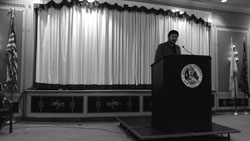Ekso-Bionics Brings Freedom to Wheelchair-Bound
Most of us took our first steps as toddlers as we were watched excitedly by our parents in the comfort of our homes. As the days passed, we gained experience and walked upright, pushed our chests out and marveled at our own accomplishment.
As the days turned to years, some lost that privilege and were told by the doctor that we could not walk again. Car accidents, construction accidents surfing accidents, and skiing accidents among a myriad of others have robbed them of the freedom of walking free.
Recently, that freedom has not only been restored, but has been revamped like never before.
A collaboration of professionals in mechanical engineering, electrical engineering, programming and medicine in the Californiabased
Ekso Bionics, has given people in wheelchairs a second opportunity at taking their first steps. Ekso is a bionic exoskeleton that allows paraplegics to stand up from their wheelchairs and walk upright. Armed with four motors and fifteen electrical sensors, the battery powered and ready-to-wear device allows the patient, according to eksobionics.com, to walk over ground with a natural gait, assisted by advanced balance and positioning systems. In only five minutes, the patient can transfer from his or her wheelchair to the device with minimal assistance, and on their own with experience.
Eythor Bender, CEO of Ekso Bionics, believes that we are at a crossroads in the history of mobility. Up until now, bionic exoskeletons were contraptions portrayed in the form of sci-fi avatars or robots. We have reached the “tipping point” of scientific advancement where we now hold the ability to turn dreams and hope into reality, according to eksobionics.com.
“Many things had to happen over the last year to get us to where we are today,” said Bender. “A dedicated team of employees and test pilots has been working towards the goal of helping people to realize their dreams of standing up and walking.”
Jerry, an Ekso test pilot, was living in San Diego prior to his injury. He would surf every day, hike with his dog and relish the pride of starting his own business. One night, however, he dove into a swimming pool and hit his head on the f loor, breaking his sixth cervical vertebrae and pinching his spinal cord, leaving him paralyzed from the chest down from doing something he had done countless times before. Even though his life changed in an instant, Jerry would not change the way he chose to live it.
“After a few months of being sad and feeling sorry for myself,” Jerry said, “I realized that I was affecting everybody around me in a negative way. So one day I decided to just live my life and be happy and figure out new ways to do the things that I loved to do.”
The exoskeleton, Jerry recounted, is “effortless.” I can stand up in that for hours and not get tired. I really hope that the device will keep progressing and getting better and smaller than before. Who knows, maybe one day we can just eliminate wheelchairs altogether.”
Shivam Patel, sophomore biology major, said, “It’s pretty shocking to see how much mechanical engineering can do. The Ekso bionic exoskeleton can finally provide a worthy wheelchair replacement for people who have a spinal cord injury.”
Mike Minkin, senior health studies major, thinks Ekso is “Very, very cool. I am incredibly impressed with how technology has advanced. An exoskeleton device gives a human being a sense of individualism and confidence to continue doing the things they love. I can’t wait to see what happens in the next few years.”
Everyone remembers when man began to walk on the moon. Now man will walk from a wheelchair.
Since its startup, Ekso Bionics has forged partnerships with world-class institutions like UC Berkeley, received research grants from the Department of Defense and has licensed technology to the Lockheed Martin Corporation. The company continues to chart its own path through this new ocean of scientific progress that glistens with the capability and tenacity of human will.
“For decades,” said Dr. Jia Luo, chemistry professor, “the powered exoskeleton technology has been explored to augment the human body and its capabilities for military purposes. Recently, researchers and designers have strived to overcome the technical hurdles to make powered exoskeletons affordable and practical for civilian use. The exoskeleton system from Ekso Bionics is a truly remarkable example and has the potential to revolutionize healthcare.”
Ever marked by the aberrant tides of conventional acceptance, modern science must continue to uphold its trusted duty to engineer the notion of a “no” into the concept of a “yes” for the betterment of the global populace.
PHOTO COURTESY of eksobionics.com


